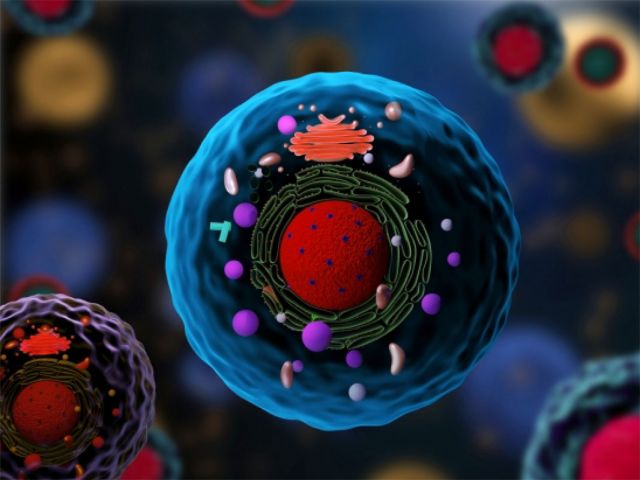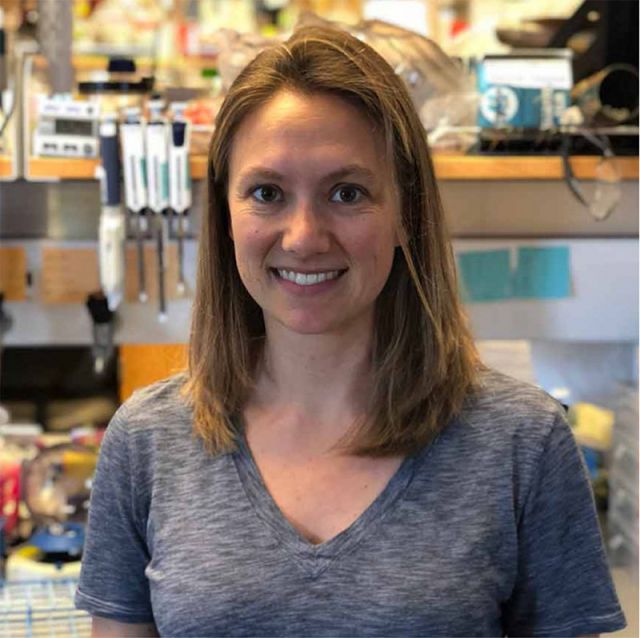Solving the Peroxisome Puzzle
MCDB professor Brooke Gardner receives a 2021 Searle Scholar award.

By Sonia Fernandez
The ability to make membrane-bound organelles is a defining characteristic of eukaryotic cells — cells that constitute the bodies of all animals, plants and fungi on Earth. Membranes create enclosures that provide specialized environments for certain structures and their functions, such as the nuclei that store genetic information, or the mitochondria that produce energy for the cell.
Of the handful of such organelles in the eukaryotic cell, one in particular intrigues UC Santa Barbara biochemist Brooke Gardner. It’s called the peroxisome, and it’s the Swiss army knife of membrane-bound organelles.
“I like to think of it as the room in the house that could be an office, a nursery or a gym, whatever the cell needs it to be,” said Gardner, an assistant professor in the Department of Molecular, Cellular, and Developmental Biology (MCDB). Peroxisomes are relatively simple organelles with diverse functions, including metabolizing lipids and processing reactive oxygen, in environments isolated from the rest of the cell. Cells can not only adjust the size and functions of these structures, they can also create new ones as needed.
For all their essential functions, however, peroxisomes are largely a mystery.
“They have certainly been proved to have different functions, but we still don’t know things like how do proteins cross the peroxisome’s membrane?” Gardner said. “It’s a big black box at this point.” With a stronger foundational knowledge of the organelle’s basic biology, we could take steps toward treating some rare genetic disorders, she added.

Now, with support from the Searle Scholars Program, Gardner is aiming to bring us to a better understanding of the versatile and vital peroxisome, and its relationship to the rest of the cell.
“I am thrilled to be named a Searle Scholar,” Gardner said. “This award gives us the freedom to try some of the riskier projects that I have in mind, and I am grateful for the opportunity to pursue these ideas.”
“Professor Gardner is an outstanding scientist who is highly deserving of this award,” said Frederick Dahlquist, MCDB department chair. “She has joined a group of remarkable younger faculty that assure a bright future for biology at UCSB.”
Using a variety of methods, including gene-based CRISPRi technology and cryo-electron microscopy, Gardner and collaborators will endeavor to solve some puzzles of basic peroxisome biology. How do gene mutations impact these organelles’ functions? What mammalian factors are involved in the peroxisome assembly and maintenance? How does stress on the organelle affect the rest of the cell? She will work with graduate student Jonathan Vu and fellow MCDB assistant professor Chris Richardson to screen for novel mammalian peroxisome genes, and with research associate (and former UCSB undergrad) Connor Sheedy she’ll endeavor to determine how disease-causing mutations impact peroxisome formation.
Gardner is the fifth UC Santa Barbara faculty member to receive an award from the Searle Scholars Program, which seeks to fund innovative, high-risk, high-reward research in biochemistry, cell biology, genetics, immunology, neuroscience, pharmacology and related areas in chemistry, medicine and the biological sciences. Previous recipients include Joel Rothman and Kathleen Foltz in the Department of Molecular, Cellular and Developmental Biology; Irene Chen in the Department of Chemistry; and Sung Soo Kim, also in MCDB. In general, the program makes 15 new grants annually.
Gardner received her bachelor’s degree in biochemistry from Middlebury College and her Ph.D. in biochemistry from UC San Francisco, followed by a Miller Research Fellowship at UC Berkeley. She joined the UC Santa Barbara faculty in 2019.
The Searle Scholars Program was founded in 1980. It is funded through the Searle Funds at the Chicago Community Trust established by the estates of Mr. and Mrs. John G. Searle. John G. Searle was the grandson of the founder of the global pharmaceutical company, G.D. Searle & Company.